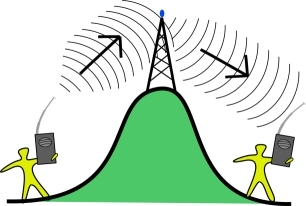Conventional frequencies can be used in simplex (direct) or repeated mode. Simplex means that Radio A and Radio B will both transmit and receive on the same frequency. Their transmissions will not pass through a radio tower, instead going directly from radio to radio. Radio A and Radio B must be within range of each other to communicate.
 A repeater is a device placed atop a tall building or radio tower that listens to one frequency and rebroadcasts everything it hears over another frequency in real time. With the repeater at a higher elevation, range is generally much greater than it would be using simplex mode. Anyone in range of the repeater can talk to anyone else who is also in range of the repeater – even if they are not in range of each other.
A repeater is a device placed atop a tall building or radio tower that listens to one frequency and rebroadcasts everything it hears over another frequency in real time. With the repeater at a higher elevation, range is generally much greater than it would be using simplex mode. Anyone in range of the repeater can talk to anyone else who is also in range of the repeater – even if they are not in range of each other.
Repeated mode is ideal for communicating over long distances, but can provide poor in-building coverage depending on how far you are from the repeater. Simplex can offer superior in-building or close range coverage when the repeater is far away or unavailable.
Communications between a field user and a medical helicopter should always be done in simplex mode. A helicopter, transmitting from the sky, can communicate on simplex over long distances and would cause interference if it attempted to use the repeater.
In BRICS radios, conventional frequencies in the direct mode are labeled with a “D”.
Example: 8 TAC 92D vs. 8 TAC 92